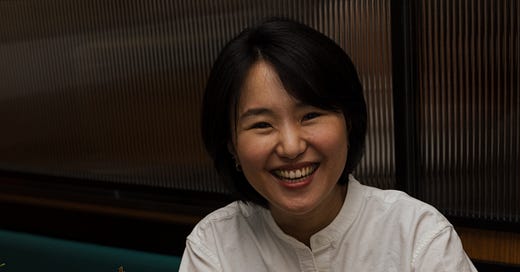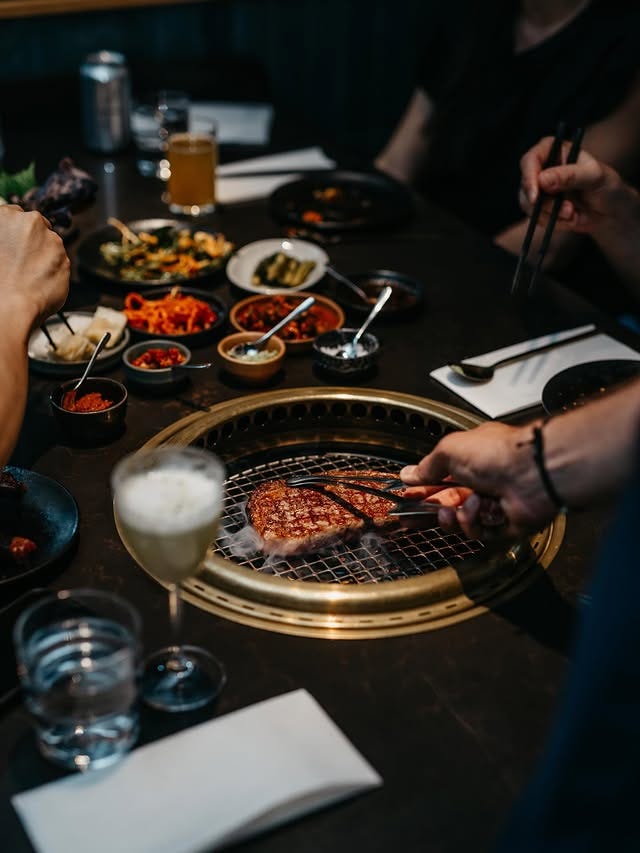Day in the life of a front-of-house worker
Yuna Landau, the GM at Takja BBQ, tells me what it's like as the "invisible" face of a restaurant.
Despite being the first person you see when you enter a restaurant, and the people most diners interact with, front-of-house workers don’t get much love in food media.
Sure, The Bear has a whole side plot that celebrates the maître d’s, hosts, servers and wait staff that make a restaurant run smoothly. But in the magazine world, the reverence is reserved solely for the chefs—figures that most diners will never meet while eating out. For most diners, it’s the service that makes a restaurant stand out: even the blandest food is improved upon with fantastic service, and great food with snooty service almost always guarantees complaints (if not outright personal boycotts of restaurants if a diner thinks they’ve been mistreated in some way… we’ve all been there).
So, I paid Takja BBQ House a visit.
Things are a little bit different at Takja. The upscale Korean barbecue place on College Street West is one of the few KBBQ places in Toronto where the food is cooked for you, table-side—most other places leave diners to grill for themselves, resulting in a fun and somewhat stressful situation. The servers are also the chefs at Takja.
It’s a reversal of roles forYuna/Yunjung Landau, Takja’s general manager who has worked in hospitality for over a decade.
Landau knows that being a front-of-house worker in a restaurant means being a little bit invisible: even as they’re the ones customers interact with, “the chefs are the ones called artists,” Landau says. But that doesn’t mean that front-of-house workers have no part in creation. “The front-of-house manager, or whoever runs the operation, is part of that art too,” she says, explaining that she and her team are responsible for making a diner’s experience as seamless as possible so that they can enjoy the art the chefs create.
And it’s not just the fact that she’s cooking that makes her one of Takja’s artists. While Landau has been a part of many restaurant openings, this is the first time she got to be a part of the design process. She helped pick out the lighting, the tables and worked with the chefs to design the menu. She also got to flex her knowledge of Korean dining and culture to train the staff to be knowledgable in Korean BBQ while still maintaining a Canadian flair that will be familiar for most diners in the city. “I wanted customers to come in and actually feel like they’re home and have a good experience,” she says.
So what’s a day in the life look like for Landau?
Landau gets to the restaurant a couple hours before service begins—around 3PM when dinner starts at 5. She starts every shift by taking a look at the restaurant’s OpenTable, going over the reservations for the night ahead, making sure there isn’t too much of a rush between tables, no overlaps, and then seeing if there’s any room for walk-ins. She’ll also also scan the days ahead to see if there are any special guests or requests coming up, things like birthdays or anniversaries, so they can be adequately prepped. Repeat customers are also flagged—at Takja, staff know their customers well, including how they like their meat cooked.
Next comes family meal, which is served about an hour before opening. Prepped by one of the chefs, the family meal is time for everyone on staff to get together, sit and eat. This is one of the most important parts of the day for Landau, who says that this half hour is where the staff can connect. “During service, we don’t have a lot of time to chat, but I want to know what everyone is up to,” she says. “Those relationships are very important.” The staff will also put aside a few portions for employees coming later in the shift, so they can eat too.
When family meal is done, and everything is cleaned up, then comes the pre-shift meetings. Here, Landau will take the opportunity to discuss special reservations, any offers and dishes that servers can share with diners and mention when during the shift there might be a busy period. The chefs will also share any special dishes there are as well as any substitutions there might be on the menu. This is so everyone is on the same page before service.
And then, after one last scan of the restaurant to ensure the whole place is spotless, doors open promptly at 5pm.
It’s a coordinated dance to get that proverbial gallery ready for the guests. The work might not be seen by most diners, but it is certainly felt. Eating at Takja, and any restaurant with front-of-house staff that care this much about diners, is a treat. With everything else accounted for (the music is at a just-right volume, the food comes at the perfect time, refills for water are excellently timed, the vibes are overall good), it lets the diners focus on enjoying the art: a cacophony of aged and marinated meats and a number of side dishes and banchan created by the unseen chefs.
Takja BBQ House, 962 College Street, @takja_bbq, takja.ca.
Three bites I can’t stop thinking about:
🥪 : Chicken parm sando ($13) from Simpl Things. Evelyn Chick, the mind behind Simpl Things, is also the brain the annual Feastie Sip and Snack festival in July. Designed to highlight BIPOC and women-owned food businesses in the city, it’s THE place to be this summer for some good eats. I went to the festival’s preview earlier this week and tried this perfect sandwich at Simpl Things’ stall. With soft bread, a massive chunk of fried chicken and delicious tomato sauce, it simply does NOT get better than that.
🐟: Unagi don from Kiro Sushi ($23). This is one my absolute favourite sushi places in Toronto. For one: the rice is WARM, which makes everything that much more comforting (why do so many sushi places let their rice get cold?!?!?). I usually go for sashimi at Kiro (they have some of the freshest fish in Toronto), but I opted for their unagi don my last visit, and was floored by the softness of the eel, the deepness of their homemade unagi sauce and of course… the warm rice.
🍚: Wild greens stone pot rice/bibimbap from Takja ($24). Made with a number of seasonal veggies, this bibimbap is super simple but impactful. The bitter greens pair with the nuttiness of the crispy rice at the bottom of the pot for a perfect BBQ side.







